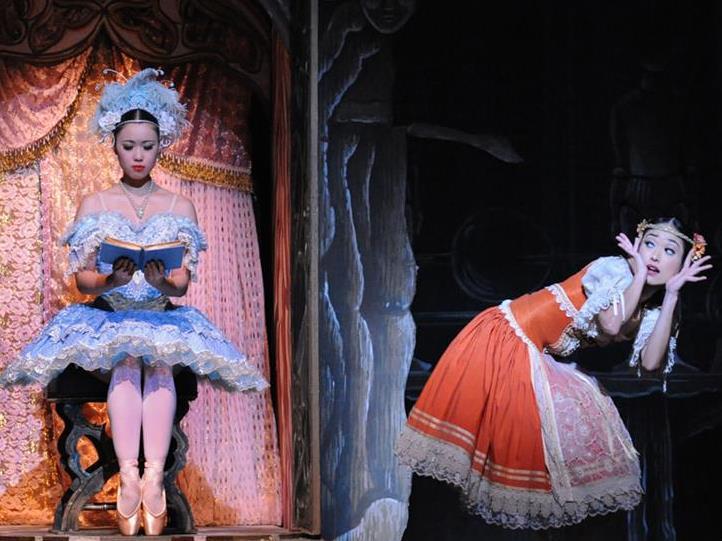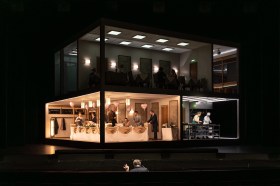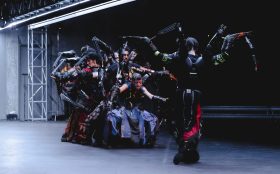Australian Ballet’s Coppélia photograph via Australian Ballet.
As the curtain rose for the opening night of Australian Ballet’s Coppélia at St Kilda’s Palais Theatre, it revealed what appeared to be a replica of the original program for the premiere, in Paris in 1870, of Coppélia as The Girl with the Enamel Eyes by Léo Delibes in Three Tableaux.
In front of the stage, in full view, was Orchestra Victoria, directed by multi-talented conductor, Nicolette Fraillon and, behind her, a full house of balletomanes, young, old and enthusiastic, whether they’d never seen this classic tale or they’d seen it a dozen times. But maybe they hadn’t seen it under the faultless direction of David McAllister and the dancers he has nurtured with such inciteful care. Apart from giving many members of the corps de ballet a chance to shine in those beautiful Kristian Frederikson costumes, his choice of Principal dancers, Ako Kondo and Chenwu Guo, brought this performance of Coppélia to a level it will be hard to surpass.
In performances by overseas companies I had been surprised at the small stature of many of the dancers as opposed to some Australian dancers. Kondo, from Japan, has said she felt conscious of her small size when she first began dancing in Australia but considered she made up for it with her energy and speed and indeed she does. As Swanilda, the mischievous, inquisitive village girl, her movements were light, agile and spirited to match a miming ability that must make Director, George Ogilvie, proud.
Her combination with Chengwu Guo, as Franz, created a magic that comes with people who are partners on stage as well as in life. For both it has been a struggle to make a home in a strange country, particularly for Guo, from China. His story is not unlike that of Li Cunxin, whose teenage years Guo depicted in the film, Mao’s Last Dancer. As well as Cunxin, I thought of Nureyev, when Guo first leapt onto the stage. Small in stature he may be, but his jetés and turns were precise, confident and breathtaking.
The story of the girl doll invented by the sorcerer, Dr Coppelius, was originally written by E.T.A. Hoffman in 1816 but when it first came to life as a ballet, in 19th century France, it was heavily influenced by a societal trend towards mysticism, magic and soul transference. It is a credit to the Australian Ballet that it has made an excellent program available to give a comprehensive explanation of what may appear, on the surface, to be a story for children but is, in fact, quite dark in meaning as many nursery rhymes and fairy tales, from that time, have been.
Andrew Killian is suitably mysterious and obsessed with his doll, Aya Watanabe, whose apparent indifference has entranced Franz. Swanilda’s jealousy and curiosity lead her and her friends to Coppelius’ studio where his many strange dolls come to life. This second Act gives Kondo, taking the place of the doll, an opportunity to show her versatility with bursts of Spanish and Scottish dancing as Coppelius tries to distract her from Franz whom he has placed on a spinning wheel designed to transfer his soul to his doll and bring her to life. It’s serious alchemy but never loses the spirited sense of fun that permeates the whole production.
Act III’s ‘celebration of life’ gives Kondo and Guo an opportunity for a beautiful pas de deux and, finally, thunderous applause from an appreciative audience.
The Palais may certainly be in need of the urgent maintenance it has been promised but, clearly, this theatre, which has hosted 10 world premieres, was still the perfect venue for Coppélia today.
Rating: 5 stars out of 5
COPPÉLIA
THE AUSTRALIAN BALLET
Artistic Director David McAllister AM
Devised and director by George Ogilvie
Original choreography Arthur Saint-Léon
Additional choreography Peggy van Praagh
Guest Repetiteur Mark Kay
Set and costume design Kristian Fredrikson
Lighting design Francis Croese
Music byLéo Delibes
Music Director and Chief Conductor Nicolette Fraillon with Orchestra Victoria
VENUE: Palais Theatre, St Kilda
DATES: 23 September – 1 October 2016
Sydney, 2 December – 21 December 2016





